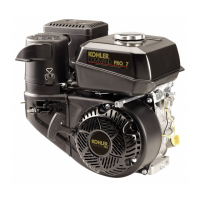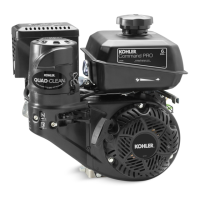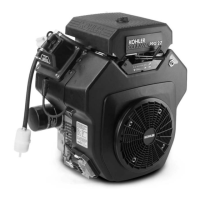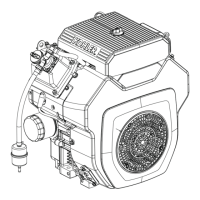5.1
Section 5
Fuel System and Governor
5
Section 5
Fuel System and Governor
Description
This section covers the carbureted fuel systems used
on these engines. The governor system is covered at
the end of this section.
WARNING: Explosive Fuel!
Gasoline is extremely fl ammable and its vapors can explode
if ignited. Store gasoline only in approved containers, in
well ventilated, unoccupied buildings, away from sparks or
fl ames. Do not fi ll the fuel tank while the engine is hot or
running, since spilled fuel could ignite if it comes in contact
with hot parts or sparks from ignition. Do not start the
engine near spilled fuel. Never use gasoline as a cleaning
agent.
Fuel System Components
The typical carbureted fuel system and related
components include the following:
• Fuel Tank
• Fuel Line
• Fuel Tank Fuel Filter
• In-line Fuel Filter
• Fuel Strainer Screen In Carburetor
• Carburetor
Operation
The fuel tank outlet is located above the carburetor
inlet, allowing gravity to feed fuel through the in-line
fi lter and fuel line to the carburetor.
Fuel then enters the carburetor through a fuel shut-
off valve and a fi ne screen/sediment bowl, and then
to the carburetor fl oat bowl. Fuel is drawn into the
carburetor body and is mixed with air. This fuel-air
mixture is then burned in the engine combustion
chamber.
Fuel Recommendations
General Recommendations
Purchase gasoline in small quantities and store
in clean, approved containers. A container with a
capacity of 2 gallons or less with a pouring spout is
recommended. Such a container is easier to handle
and helps eliminate spillage during refueling.
• Do not use gasoline le over from the previous
season, to minimize gum deposits in your fuel
system and to ensure easy starting.
• Do not add oil to the gasoline.
• Do not overfi ll the fuel tank. Leave room for the
fuel to expand. See Figure 5-1.
Maximum
Fuel Level
Filler
Neck
Filler
Neck
Fuel Tank
Fuel Tank
Filter
Figure 5-1. Maximum Fuel Level.
